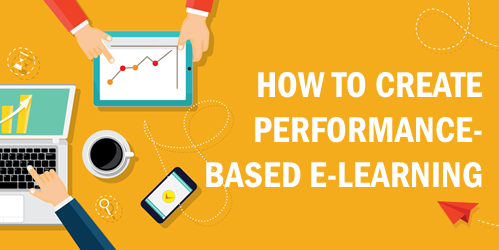I think the key thoughts here are a good starting point to looking at a performance issue. But if the business objective is not being met, especially if training has already been done, then the performance issue might not be related to a lack of skills/knowledge. There are many other reasons why performance may be lacking, and suggesting gearing even more training towards it without even considering other aspects such as the environment might be going down the wrong direction. The solution may require a human performance technology approach.
How to Create Performance-based E-Learning
February 18th, 2020
E-learning courses generally fall into one of two buckets: tell people something or show them how to do something. One is all about the information and the other about performance. Both approaches have value.
The reality is that a lot of e-learning is information-based and mostly driven by compliance requirements. Outside of certification of completion, there’s little performance requirement other than compliance to the policies or directives.
For example, generally you don’t have an organization full of sexual harassers and then present a course on sexual harassment and all of a sudden they’re no longer harassing. Instead, the course informs about sexual harassment and the organization’s standard. And the expectation is compliance to that standard. In that sense, the course is information-based because other than compliance, there’s not a performance expectation.
Performance-based E-Learning
On the other side are performance-based courses where the goal is to change behaviors or teach new skills. Those are courses that make a difference (in the sense that one goes from A to B). So how do you know those courses will make a difference?
Here are a few key thoughts to help get there.
- What are the business objectives?
- Why aren’t they meeting those goals today?
- What training do they currently receive (if any)? Why hasn’t it worked?
- How is the course linked to meeting the objectives?
- What do you expect the learners to do after the course that they’re not doing today?
- How will you measure the success of the course?
Performance-based courses are tied to the performance requirements: what are they supposed to do to meet X objective?
Focus on the performance requirement and the actions associated with it. Then build your training around that. In a sense, I like the course to “throw people into the pool.” This gets them to make the types of decisions they’ll make in the real world. If the course is performance-based, design it around those decisions rather than pages of content and policies. All of that content is important, but you can tease it out in the decision-making process and subsequent consequences.
Courses make a difference when they make things different. If you course doesn’t change behaviors or teach new skills, then it’s probably not performance-based. And how you approach the design of it is different than just pushing out information.
Events
- Everyday. Check out the weekly training webinars to learn more about Rise, Storyline, and instructional design.
Free E-Learning Resources
 |
 |
 |
|
Want to learn more? Check out these articles and free resources in the community. |
Here’s a great job board for e-learning, instructional design, and training jobs |
Participate in the weekly e-learning challenges to sharpen your skills |
 |
 |
 |
|
Get your free PowerPoint templates and free graphics & stock images. |
Lots of cool e-learning examples to check out and find inspiration. |
Getting Started? This e-learning 101 series and the free e-books will help. |









0
comments